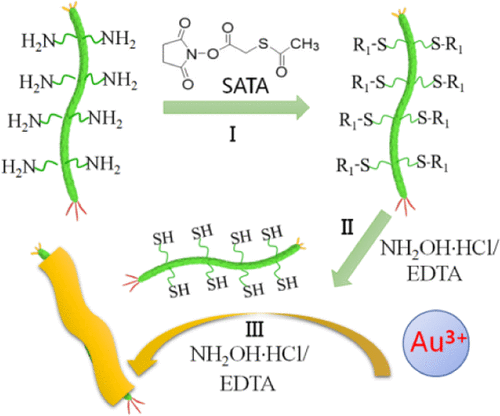Our official English website, www.x-mol.net, welcomes your
feedback! (Note: you will need to create a separate account there.)
Bioreduction of Gold Ions under Greener Conditions by the Thiol-Modified M13 Bacteriophage and with Hydroxylamine as the Autocatalytic Reducing Agent
ACS Omega ( IF 3.7 ) Pub Date : 2022-03-08 , DOI: 10.1021/acsomega.2c00563 Zongwu Wei 1 , Xueyan Wei 1 , Chenxi Zhao 2 , Han Zhang 1 , Zhenkun Zhang 2
ACS Omega ( IF 3.7 ) Pub Date : 2022-03-08 , DOI: 10.1021/acsomega.2c00563 Zongwu Wei 1 , Xueyan Wei 1 , Chenxi Zhao 2 , Han Zhang 1 , Zhenkun Zhang 2
Affiliation

|
Bioreduction of gold ions by the thiol-modified M13 bacteriophage (M13-SH) has been exploited as the potential alternative to conventional methods based on toxic chemicals, due to the gold affinity of the thiol groups, inherent gold reduction, and high specific surface area of the filamentous virus. Such efforts have been hindered by harsh conditions involving strong reducing agents and extreme pH that are harmful to the virus. Herein, a virus-friendly and greener method of bioreduction of AuCl4– at neutral pH based on M13-SH is demonstrated. M13-SH was prepared by coupling the virus with N-succinimidyl S-acetylthioacetate, followed by deacylation in the presence of hydroxylamine·HCl to expose the thiol groups. The key finding is that without time-consuming purification, the mixture after deacylation consisting of M13-SH, residual hydroxylamine, and so forth can directly turn ionic gold species into gold, leading to macroscopic precipitated products with interconnected linear structures consisting of fused gold nanoparticles. Besides working as the virus-friendly reducing agent with a unique autocatalytic style, hydroxylamine diminishes disulfide bonding-induced intervirus bundling of M13-SH so as to maintain its efficient biosorption of ionic gold precursors. This work demonstrates a general and green strategy of bioreduction of gold via combination of the gold-affinity proteins or organisms and the unique autocatalytic reduction of hydroxylamine.
中文翻译:

硫醇修饰的 M13 噬菌体和羟胺作为自催化还原剂在绿色条件下生物还原金离子
由于硫醇基团对金的亲和力、固有的金还原和高比表面积,硫醇修饰的 M13 噬菌体 (M13-SH) 对金离子的生物还原已被用作基于有毒化学品的常规方法的潜在替代方法的丝状病毒。这些努力受到了恶劣条件的阻碍,包括对病毒有害的强还原剂和极端 pH 值。本文展示了一种基于 M13-SH 在中性 pH 值下生物还原 AuCl 4的病毒友好且更环保的方法。通过将病毒与N-琥珀酰亚胺S偶联制备 M13-SH-乙酰硫代乙酸酯,然后在羟胺·HCl的存在下脱酰基以暴露硫醇基团。关键发现是,无需耗时纯化,脱酰后由 M13-SH、残留羟胺等组成的混合物可以直接将离子金物质转化为金,从而产生由熔合金纳米粒子组成的具有互连线性结构的宏观沉淀产物. 除了作为具有独特自催化方式的病毒友好型还原剂外,羟胺还减少了二硫键诱导的 M13-SH 病毒间集束,从而保持其对离子金前体的有效生物吸附。这项工作展示了一种通过结合金亲和蛋白质或生物体以及独特的羟胺自催化还原来生物还原金的通用和绿色策略。
更新日期:2022-03-08
中文翻译:

硫醇修饰的 M13 噬菌体和羟胺作为自催化还原剂在绿色条件下生物还原金离子
由于硫醇基团对金的亲和力、固有的金还原和高比表面积,硫醇修饰的 M13 噬菌体 (M13-SH) 对金离子的生物还原已被用作基于有毒化学品的常规方法的潜在替代方法的丝状病毒。这些努力受到了恶劣条件的阻碍,包括对病毒有害的强还原剂和极端 pH 值。本文展示了一种基于 M13-SH 在中性 pH 值下生物还原 AuCl 4的病毒友好且更环保的方法。通过将病毒与N-琥珀酰亚胺S偶联制备 M13-SH-乙酰硫代乙酸酯,然后在羟胺·HCl的存在下脱酰基以暴露硫醇基团。关键发现是,无需耗时纯化,脱酰后由 M13-SH、残留羟胺等组成的混合物可以直接将离子金物质转化为金,从而产生由熔合金纳米粒子组成的具有互连线性结构的宏观沉淀产物. 除了作为具有独特自催化方式的病毒友好型还原剂外,羟胺还减少了二硫键诱导的 M13-SH 病毒间集束,从而保持其对离子金前体的有效生物吸附。这项工作展示了一种通过结合金亲和蛋白质或生物体以及独特的羟胺自催化还原来生物还原金的通用和绿色策略。


















































 京公网安备 11010802027423号
京公网安备 11010802027423号